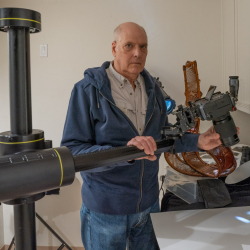Home > Topics > Equipment & Techniques > Cameras, Lenses and Shooting Gear > Sony A7R3 shoot compressed or uncompressed?
Sony A7R3 shoot compressed or uncompressed?
-
AuthorTopic: Sony A7R3 shoot compressed or uncompressed? Read 31352 Times
-
Sony A7R3 shoot compressed or uncompressed?on: September 15, 2019 at 5:36 pm
Thankyou for the explaining the new algorithm.
Just to be clear, this is the same algorithm the a7x cameras have used since day one.
Re: Sony A7R3 shoot compressed or uncompressed?Reply #1 on: September 15, 2019 at 5:44 pmTo see this one would implement the compression algorithm and run it on an uncompressed image and store the difference frame.
The way you calculate the difference frame is important.
https://blog.kasson.com/the-last-word/a-tough-test-of-sony-raw-compression/
Re: Sony A7R3 shoot compressed or uncompressed?Reply #2 on: September 15, 2019 at 6:31 pmTo see this one would implement the compression algorithm and run it on an uncompressed image and store the difference frame.
The way you calculate the difference frame is important.
https://blog.kasson.com/the-last-word/a-tough-test-of-sony-raw-compression/
What I mean by this: Implement the compression algorithm in software to post-process an uncompressed raw image. Compress the image, decompress it and then subtract from the original uncompressed image. That will show what is being lost by the compression algorithm.
For doing a running sum difference frame on a Mosaic Sensor: do a running difference of elements of the same color on the same row. Store the differences as 8-bit signed values from -127 through +126, reserve 127 as an escape value to store the actual value for when the difference exceeds -127:126. If the encoded difference frame exceeds the original image size, switch to storing an uncompressed frame. Computationally expedient, best to store the original image if the running difference takes too much space. The point response of the sensor+lens is important, tends to work best on oversampled data. Worked 30 years ago.
My Micro-Nikkor AFD 200/4 is one of the sharpest lenses that I own. Online reports state that it is well matched to a 16MPixel sensor. I wonder how many Sony A7RIII images are taken using lenses that outperform the sensor.
-
This reply was modified 4 years, 7 months ago by
Brian Sweeney.
-
This reply was modified 4 years, 7 months ago by
Brian Sweeney.
Re: Sony A7R3 shoot compressed or uncompressed?Reply #3 on: September 15, 2019 at 11:46 pmTo see this one would implement the compression algorithm and run it on an uncompressed image and store the difference frame.
The way you calculate the difference frame is important.
https://blog.kasson.com/the-last-word/a-tough-test-of-sony-raw-compression/
What I mean by this: Implement the compression algorithm in software to post-process an uncompressed raw image. Compress the image, decompress it and then subtract from the original uncompressed image. That will show what is being lost by the compression algorithm.
For doing a running sum difference frame on a Mosaic Sensor: do a running difference of elements of the same color on the same row. Store the differences as 8-bit signed values from -127 through +126, reserve 127 as an escape value to store the actual value for when the difference exceeds -127:126. If the encoded difference frame exceeds the original image size, switch to storing an uncompressed frame. Computationally expedient, best to store the original image if the running difference takes too much space. The point response of the sensor+lens is important, tends to work best on oversampled data. Worked 30 years ago.
My Micro-Nikkor AFD 200/4 is one of the sharpest lenses that I own. Online reports state that it is well matched to a 16MPixel sensor. I wonder how many Sony A7RIII images are taken using lenses that outperform the sensor.
We don’t appear to be communicating. Did you read the blog post I linked to above? In that post i described creating synthetic images, compressing them, decompressing them, and comparing them to the originals. My point about the difference is made in the posts, too: if you just subtract the images, you lose half the information. You need to be abit more cleaver about the difference calculations.
WRT lenses outperforming the sensor, it’s been my experience that any good lens, on-axis at anywhere near the best aperture for that lens, can create aliasing on even the 3.76 um sensors.
https://blog.kasson.com/gfx-100/iq4-150-gfx-100-a7riv-different-slices-off-the-same-sausage/
Re: Sony A7R3 shoot compressed or uncompressed?Reply #4 on: September 16, 2019 at 10:27 amI use 32-bit signed integers, do a frame-to-frame subtract, and do not lose any information. The difference frame is a signed value. Used for MTI a long time ago.
Re: Sony A7R3 shoot compressed or uncompressed?Reply #5 on: September 16, 2019 at 3:05 pmI use 32-bit signed integers, do a frame-to-frame subtract, and do not lose any information. The difference frame is a signed value. Used for MTI a long time ago.
How do you display an int32 image, as opposed to a uint32 one? That’s the point of my post. And why use 32-bit arithmetic on 14-bit unsigned integer values?
-
This reply was modified 4 years, 7 months ago by
-
AuthorPosts
- You must be logged in to reply to this topic.




